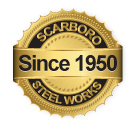Structural Steel Fabricators - Shearing in Steel Fabrication
Structural Steel Fabrication – Shearing in Steel Fabrication
Fabrication is an important process in the manufacture of structural steel components to form a complete frame. Structural steel fabricators normally carry out work on the shop but there are instances when fabrication has to be done in the construction site when the components are excessively large to be transported. Structural steel fabrication on site is very typical for large projects and structural steel fabricators follow the same sophisticated methods to ensure high standards of quality.
The process of shearing in structural steel fabrication
In the fabrication of structural steel, the first step is usually cutting. The cutting process can be handled through band saws, oxy-fuel cutting, plasma cutting, laser cutting or shearing. Shearing however is limited to steel parts that include angles, channels, flat stock and beams. Two types of shearing methods are used to cut miscellaneous structural steel elements. Structural steel fabricators can either use single cut shearing or double-cut shearing after considering several important factors.
Single-cut shearing makes use of one fixed blade and one movable blade. The material is properly positioned through a hold-down device on the in-feed side of the shear.
Double-cut shearing is totally different from the single-cut shearing because it uses three cutting tools; an upper, movable blade that functions like a punch, lower fixed knives that act like a die and upper movable blades that generate material loss equal to blade thickness for each cycle. Double-cut is employed by structural steel fabricators on plates and barstock.
Factors considered when shearing
The thickness of the upper blade in double-cut shearing is determined by the maximum thickness of the material being sheared. For example, if a double-cut tool will be used for shearing a flat stock that measures 1 inch in thickness, the upper blade must also be 1-inch thick to be able to generate material loss or kerf for each shearing cycle. Material loss is critical in shearing. If the finished part is 20 feet long and the upper knife is 1-inch thick whatever material loss is generated from the double-cut shearing process can be considered negligible. However, when 10-inch long parts are cut, material loss can be significant at 10% of the total length.
Rake angle is another important consideration in the upper blade of the double-cut process. Structural steel fabricators reduce the cross section that is sheared at one time through rake angle. The distortion is reflected in the slug or material waste. If distortion is controlled in the slug, double-cut shearing can produce an exceptionally flat finished part. The uniform profile of flats and angles make them perfect for shearing because it can accommodate a range of sizes. However, if the application involves channels and I beams, the location of the flanges and the height of the web in the beam dictates a unique tooling geometry for each section size. Aside from the beam and channel depth, weight per foot also changes the cross section of the member. Differences in depth and weight can require a unique set of upper and lower knives for each size and weight of the channel and beam.






